Saint Germain
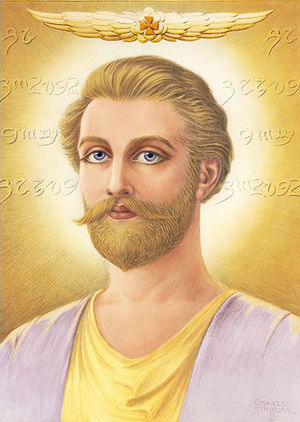
Saint Germain is the chohan of the seventh ray. Together with his twin flame, the ascended lady master Portia, the Goddess of Justice, he is the hierarch of the Aquarian age. He is the great sponsor of freedom’s flame, while Portia is the sponsor of the flame of justice.
Saint Germain is known as a diplomat, expressing the godly qualities of dignity, grace, gentility, poise and true statesmanship through all who will invoke the seventh ray. He is a member of the House of Rakoczy, founded by the Great Divine Director, in whose Transylvanian mansion the violet flame of freedom is presently enshrined.
The name Saint Germain comes from the Latin Sanctus Germanus, meaning simply “Holy Brother.”
His mission
Each two-thousand-year cycle comes under one of the seven rays. Jesus, as chohan of the sixth ray, held the office of hierarch of the age during the last 2000 years. On May 1, 1954, Saint Germain and Portia were crowned as directors for the coming cycle of the seventh ray. Freedom and justice are the yin and yang of the seventh ray of Aquarius, and together with mercy, they provide the foundation for all other attributes of God to be outpictured in this seventh dispensation.
Saint Germain and Portia deliver to the people of God the dispensation for the seventh age and the seventh ray—the violet ray of freedom, justice, mercy, alchemy and sacred ritual—a new lifewave, a new civilization, a new energy.
As chohan, or lord, of the seventh ray, Saint Germain initiates our souls in the science and ritual of transmutation through the violet flame. He is the seventh angel prophesied in Revelation 10:7 who comes to sponsor the finishing of the mystery of God “as he hath declared to his servants the prophets.”
Saint Germain says:
I am an ascended being, but it has not ever been thus. Not once or twice but for many incarnations I walked the earth as you now do, confined to mortal frame and the limitations of dimensional existence. I was on Lemuria and I was on Atlantis. I have seen civilizations rise and fall. I have seen the undulations of consciousness as mankind have cycled from golden ages to primitive societies. I have seen the choices, and I have seen mankind by wrong choices squander the energies of a hundred thousand years of scientific advancement and even degrees of cosmic consciousness that transcend that which is attained by members of the most advanced religions of the day.
Yes, I have seen the choices, and I have chosen. By right choices man and woman establish their position in hierarchy. By choosing to be free in the magnificent will of God, I won my freedom from that mortal round of incarnations and justifications of an existence outside the One. I won my freedom by that flame, that keynote of the Aquarian cycle traced by alchemists of old, that purple elixir the saints do hold....
You are mortal. I am immortal. The only difference between us is that I have chosen to be free, and you have yet to make the choice. We have the same potential, the same resources, the same connection to the One. I have taken mine to forge a God-identity. For long ago, the still small voice within spoke the fiat of Alpha and the living God: “Children of the One, forge your God-identity.” And in the stillness of the night, I heard the call and I answered, “I will!” And when I said, “I will,” all of cosmos echoed, “I will!” The will to be summons the vastness of the potential of being....
I am Saint Germain, and I have come to claim your soul and the fires of your heart for the victory of the Aquarian age. I have set the pattern for your soul’s initiation.... I am on the path of freedom. Take that path, and you will find me there. I am your teacher if you will have me.[1]
Embodiments
Ruler of a golden-age civilization
► Main article: Golden age in the Sahara Desert
Over fifty thousand years ago, Saint Germain was the ruler of a golden-age civilization in a fertile country where the Sahara Desert now is. As king-emperor, Saint Germain was a master of the ancient wisdom and of the knowledge of the Matter spheres, and the people looked to him as the standard for their own emerging Godhood. His empire reached a height of beauty, symmetry and perfection unexceeded in the physical octave.
As the people of this civilization became more interested in the pleasures of the senses than in the larger creative plan of the Great God Self, a cosmic council instructed the ruler to withdraw from his empire; henceforth their karma would be their guru. The king held a great banquet for his councillors and public servants. His 576 guests each received a crystal goblet filled with an elixir that was “pure electronic essence.”
This elixir was Saint Germain’s gift of soul-protection to them so that when their opportunity would come again in the age of Aquarius to bring back that golden-age civilization, they would remember their I AM Presence and they would become a sign to all people that God can and shall dwell with his people when they make their minds and hearts and souls a fitting habitation for his Spirit.
During the banquet a cosmic master, identifying himself solely by the word Victory upon his brow, addressed the assembly. He warned the people of the crisis they had brought upon themselves by their faithlessness, rebuked them for their neglect of their Great God Source, and prophesied that the empire would come under the rule of a visiting prince who would be seeking to marry the king’s daughter. The king and his family withdrew seven days later to the golden-etheric city counterpart of the civilization. The prince arrived the next day and took over without opposition.
High priest on Atlantis
As high priest of the Violet Flame Temple on the mainland of Atlantis thirteen thousand years ago, Saint Germain sustained by his invocations and his causal body a pillar of fire, a veritable fountain of violet singing flame, which magnetized people from near and far who came to be set free from every binding condition of body, mind and soul. This they achieved by self-effort through the offering of invocations and the practice of seventh-ray rituals to the sacred fire.
Those who officiated at the altar of the Violet Flame Temple were schooled in the universal priesthood of the Order of Melchizedek at Lord Zadkiel’s retreat, the Temple of Purification, which stood where the island of Cuba now is. This priesthood combines the perfect religion and the perfect science. It was here that both Saint Germain and Jesus received the anointing, spoken by Zadkiel himself: “Thou art a priest for ever after the order of Melchizedek.”
Prior to the sinking of Atlantis, while Noah was yet building his ark and warning the people of the great Flood to come, the Great Divine Director called Saint Germain and a few faithful priests to transport the flame of freedom from the Temple of Purification to a place of safety in the Carpathian foothills in Transylvania. Here they carried on the sacred ritual of expanding the fires of freedom even while mankind’s karma was being exacted by divine decree.
In succeeding embodiments, Saint Germain and his followers, under the guidance of the Great Divine Director, rediscovered the flame and continued to guard the shrine. Later, the Great Divine Director, assisted by his disciple, established a retreat at the site of the flame and founded the House of Rakoczy, the royal house of Hungary.
The prophet Samuel
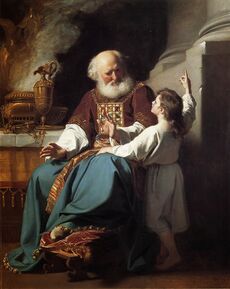
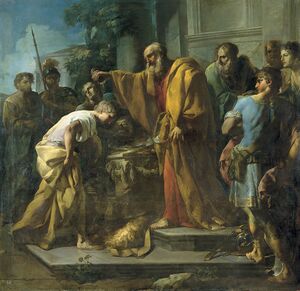
In the eleventh century B.C., Saint Germain was embodied as the prophet Samuel. He was an outstanding religious leader in a time of great apostasy, serving as the last of Israel’s judges and the first of her prophets. In those days the judges did not simply arbitrate disputes; they were charismatic leaders who were believed to have direct access to God and who could rally the tribes of Israel against oppressors.
Samuel was the messenger of God’s liberation of the seed of Abraham from bondage to the corrupt priests, the sons of Eli, and from the Philistines, who had slaughtered the Israelites in battle. He is traditionally named alongside Moses as a great intercessor. When the nation faced continuing threats from the Philistines, he courageously led the people in a spiritual revival, exhorting them to “return unto the LORD with all your hearts” and to “put away the strange gods.”[2] The people repented and beseeched Samuel not to cease calling upon the LORD to save them. As he was praying and offering sacrifices, a violent thunderstorm was unleashed, allowing the Israelites to overtake their enemies. The Philistines never rose again in the days of Samuel.
The prophet spent the rest of his life administering justice throughout the land. When he grew old, he appointed his sons to be judges over Israel; but they were corrupt and the people demanded that Samuel give them “a king to judge us like all the nations.”[3] Deeply grieved, he prayed to the LORD and received the direction that he must carry out the mandate of the people. The LORD told him, “They have not rejected thee, but they have rejected me, that I should not reign over them.”[4]
Samuel warned the Israelites of the dangers that would befall them through their rulers, but they still clamored for a king. Thus he anointed Saul as their leader and charged him and the people to always obey the voice of the LORD. But when Saul proved to be an unfaithful servant, Samuel pronounced the LORD’s judgment upon him for his disobedience and secretly anointed David as king. When the prophet died, he was buried at Ramah; all of Israel mourned his passing.
Saint Joseph
► Main article: Saint Joseph
Saint Germain was also embodied as Saint Joseph, the father of Jesus and husband of Mary. There are few references to him in the New Testament. The Bible traces his lineage back to David. It also recounts how when the angel of the Lord warned him in a dream that Herod planned to kill Jesus, Joseph heeded the warning and took his family to Egypt, returning after Herod’s death. Joseph is said to have been a carpenter and is thought to have passed on before Jesus began his public ministry. In Catholic tradition, Saint Joseph is revered as Patron of the Universal Church, and his feast is celebrated on March 19.
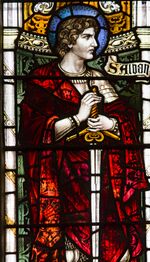
Saint Alban
In the late third century, Saint Germain was embodied as Saint Alban, the first martyr of Britain. Alban lived in England during the persecution of Christians under the Roman emperor Diocletian. He was a pagan who had served in the Roman army and settled in the town of Verulamium, later renamed St. Albans. Alban hid a fugitive Christian priest named Amphibalus, who converted him. When soldiers came to search for him, Alban allowed the priest to escape and disguised himself in the cleric’s garb.
Once his deed was discovered, Alban was scourged and sentenced to death. Legend says that so great a multitude gathered to witness his execution that they could not pass over a narrow bridge that had to be crossed. Alban prayed and the river parted to give passage to the crowd, whereupon his appointed executioner was converted and begged to die in his place. The request was denied and he was beheaded along with Alban.
Alban has been revered by the people of the Isles since his death in A.D. 303. As the Reverend Alban Butler writes in his Lives of the Fathers, Martyrs and other Principal Saints, “Our island for many ages had recourse to St. Alban as its glorious protomartyr and powerful patron with God, and acknowledged many great favours received from God, through his intercession.”
Teacher of Proclus
Saint Germain worked from inner planes as the Master Teacher behind the Neoplatonists. He inspired the Greek philosopher Proclus (c. A.D. 410–485), the highly honored head of Plato’s Academy at Athens. He revealed his pupil’s previous life as a Pythagorean philosopher, also showing Proclus the sham of Constantine’s Christianity and the worth of the path of individualism (leading to the individualization of the God flame) which Christians called “paganism.”
Under the Master’s tutelage, Proclus based his philosophy upon the principle that there is only one true reality—the “One,” which is God, or the Godhead, the final goal of all life’s efforts. The philosopher said, “Beyond all bodies is the essence of soul, and beyond all souls the intellectual nature, and beyond all intellectual existences the One.”[5]
Proclus’s writings extended to almost every department of learning, from philosophy and astronomy to mathematics and grammar. He acknowledged that his enlightenment and philosophy came from above and he believed himself to be one through whom divine revelation reached mankind.
Proclus acknowledged that his enlightenment and philosophy came from above—indeed he believed himself to be one through whom divine revelation reached mankind. “He did not appear to be without divine inspiration,” his disciple Marinus wrote, “for he produced from his wise mouth words similar to the most thick falling snow; so that his eyes emitted a bright radiance, and the rest of his countenance participated of divine illumination.”[6]
Merlin
► Main article: Merlin
In the fifth century, Saint Germain was embodied as Merlin—alchemist, prophet and counsellor at the court of King Arthur. In a land splintered by warring chieftains and riven by Saxon invaders, Merlin led Arthur through twelve battles (which were actually twelve initiations) to unite the kingdom of Britain. He worked side by side with the king to establish the sacred fellowship of the Round Table. Under the guidance of Merlin and Arthur, Camelot was a mystery school where the knights and ladies pursued the inner unfoldment of the mysteries of the Holy Grail and a path of personal Christhood.
In some traditions, Merlin is described as a godly sage who studied the stars and whose prophecies were recorded by seventy secretaries. The Prophecies of Merlin, which deals with events extending from Arthur’s time into the distant future, was popular in the Middle Ages.
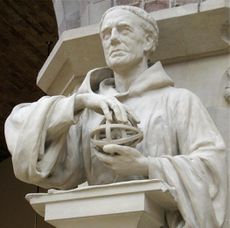
Roger Bacon
► Main article: Roger Bacon
Saint Germain was Roger Bacon (1220–1292), philosopher, Franciscan monk, educational reformer and experimental scientist. In an era in which either theology or logic or both dictated the parameters of science, he promoted the experimental method, declared his belief that the world was round, and castigated the scholars and scientists of his day for their narrow-mindedness. “True knowledge stems not from the authority of others, nor from a blind allegiance to antiquated dogmas,”[7] he said. Bacon eventually left his position as a lecturer at the University of Paris and entered the Franciscan Order of Friars Minor.
In his day Bacon was renowned for his exhaustive investigations into alchemy, optics, mathematics and languages. He is viewed as the forerunner of modern science and a prophet of modern technology. He predicted the hot-air balloon, a flying machine, spectacles, the telescope, the microscope, the elevator, and mechanically propelled ships and carriages, and wrote of them as if he had actually seen them.
His scientific and philosophical world view, his bold attacks on the theologians of his day, and his study of alchemy and astrology led to charges of “heresies and novelties,” for which he was imprisoned for fourteen years by his fellow Franciscans. But to those who followed after him, Bacon was “doctor mirabilis” (“wonderful teacher”), an epithet by which he has been known down the centuries.
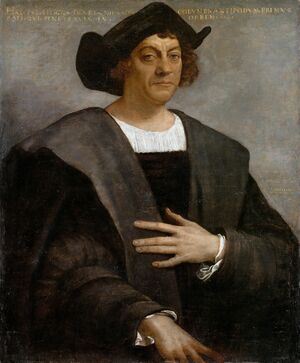
Christopher Columbus
► Main article: Christopher Columbus
Saint Germain was also embodied as Christopher Columbus (1451–1506), discoverer of America. Over two centuries before Columbus sailed, Roger Bacon himself had set the stage for Columbus’ voyage to the New World when he stated in his Opus Majus that “the sea between the end of Spain on the west and the beginning of India on the east is navigable in a very few days if the wind is favorable.”[8] Although the statement was incorrect in that the land to the west of Spain was not India, it was instrumental in Columbus’ discovery. He quoted the passage in a 1498 letter to King Ferdinand and Queen Isabella and said that his 1492 voyage had been inspired in part by this visionary statement.
Columbus believed that God had made him to be “the messenger of the new heaven and the new earth of which He spake in the Apocalypse of St. John, after having spoken of it by the mouth of Isaiah.” “In the carrying out of this enterprise of the Indies,”[9] he wrote to King Ferdinand and Queen Isabella in 1502, “neither reason nor mathematics nor maps were any use to me: fully accomplished were the words of Isaiah.” He was referring to the prophecy recorded in Isaiah 11:10–12 that the Lord would “recover the remnant of his people...and shall assemble the outcasts of Israel, and gather together the dispersed of Judah from the four corners of the earth.”[10]
He was certain that he had been divinely selected for his mission. He studied the biblical prophets, writing passages relating to his mission in a book of his own making entitled Las Proficias, or The Prophecies—in its complete form, The Book of Prophecies concerning the Discovery of the Indies and the Recovery of Jerusalem. Although the point is seldom stressed, it is a fact so rooted in history that even Encyclopaedia Britannica says unequivocally that “Columbus discovered America by prophecy rather than by astronomy.”
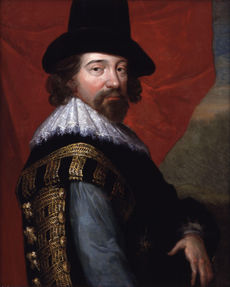
Francis Bacon
► Main article: Francis Bacon
As Francis Bacon (1561–1626), he was philosopher, statesman, essayist and literary master. Bacon, who has been called the greatest mind the West ever produced, is known as the father of inductive reasoning and the scientific method, which to a great degree are responsible for the age of technology in which we now live. He foreknew that only applied science could free the masses from human misery and the drudgery of sheer survival in order that they might seek a higher spirituality they once knew.
“The Great Instauration” (meaning the great restoration after decay, lapse or dilapidation) was his formula to change “the whole wide world.” He first conceived of the concept as a boy, and when he later crystallized it in his 1607 book by the same name, it launched the English Renaissance.
Over the years Bacon gathered around himself a group of writers who were responsible for almost all of the Elizabethan literature. Some of these were part of a “secret society” he called “The Knights of the Helmet,” which had as its goal the advancement of learning by expanding the English language and creating a new literature written not in Latin but in words that Englishmen could understand. Bacon also organized the translation of the King James Version of the Bible, determined that the common people should have the benefit of reading God’s Word for themselves.
Ciphers discovered in the 1890s in the original printings of the Shakespearean plays and in the works of Bacon and other Elizabethan authors reveal that Bacon wrote Shakespeare’s plays and that he was the son of Queen Elizabeth and Lord Leicester.[11] His mother, however, fearful of an untimely loss of power, refused to acknowledge him as her heir.
Toward the end of his life Bacon was persecuted and went unrecognized for his manifold talents. He is said to have died in 1626, but some have claimed that he secretly lived in Europe for a time after that. Triumphing over circumstances that would have destroyed lesser men, his soul entered the ritual of the ascension from the Rakoczy Mansion, retreat of the Great Divine Director, on May 1, 1684.
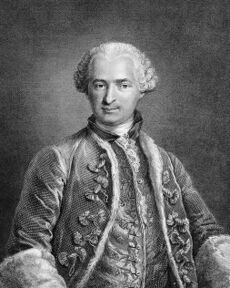
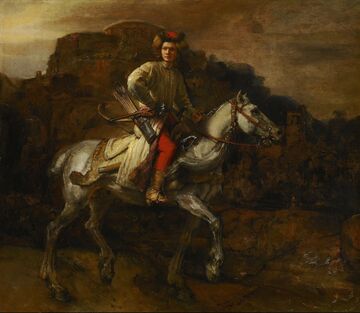
The Wonderman of Europe
► Main article: Wonderman of Europe
Desiring above all else to liberate God’s people, Saint Germain sought and was granted a dispensation from the Lords of Karma to return to earth in a physical body. He appeared as “le Comte de Saint Germain,” a “miraculous” gentleman who dazzled the courts of eighteenth- and nineteenth-century Europe, where they called him “The Wonderman.”
He was an alchemist, scholar, linguist, poet, musician, artist, raconteur and diplomat admired throughout the courts of Europe for his adeptship. He was known for such feats as removing the flaws in diamonds and other precious stones and composing simultaneously a letter with one hand and poetry with the other. Voltaire described him as the “man who never dies and who knows everything.”[13] The count is mentioned in the letters of Frederick the Great, Voltaire, Horace Walpole and Casanova, and in newspapers of the day.
Working behind the scenes, Saint Germain attempted to effect a smooth transition from monarchy to representative government and to prevent the bloodshed of the French Revolution. But his counsel was ignored. In a final attempt to unite Europe, he backed Napoleon, who misused the master’s power to his own demise.
But even prior to this, Saint Germain had turned his attention to the New World. He became the sponsoring master of the United States of America and of her first president, inspiring the Declaration of Independence and the Constitution. He also inspired many of the labor-saving devices of the twentieth century to further his goal of liberating mankind from drudgery that they might devote themselves to the pursuit of God-realization.
Chohan of the Seventh Ray
In the latter part of the eighteenth century, Saint Germain received from the lady master Kuan Yin her office as chohan of the seventh ray—the ray of mercy and forgiveness and of sacred ceremony. And in the twentieth century, Saint Germain stepped forth once again to sponsor an outer activity of the Great White Brotherhood.
In the early 1930s, he contacted his “general in the field,” the reembodied George Washington, whom he trained as a messenger and who, under the pen name of Godfré Ray King, released the foundation of Saint Germain’s instruction for the New Age in the books Unveiled Mysteries, The Magic Presence and The “I AM” Discourses. In the late 1930s, the Goddess of Justice and other cosmic beings came forth from the Great Silence to assist Saint Germain in his work of bringing the teachings of the sacred fire to mankind and ushering in the golden age.
In 1961 Saint Germain contacted his embodied representative, the messenger Mark L. Prophet, and founded the Keepers of the Flame Fraternity in memory of the Ancient of Days and his first pupil, Lord Gautama—and the second, Lord Maitreya. His purpose was to quicken all who had originally come to earth with Sanat Kumara—to restore the memory of their ancient vow and reason for being on earth today: to serve as world teachers and ministering servants in their families, communities and nations at this critical hour of the turning of cycles.
Thus, Saint Germain recalled the original keepers of the flame to hearken to the voice of the Ancient of Days and to answer the call to reconsecrate their lives to the rekindling of the flame of life and the sacred fires of freedom in the souls of God’s people. Saint Germain is the Knight Commander of the Keepers of the Flame Fraternity.
Hierarch of the Aquarian Age
On May 1, 1954, Saint Germain received from Sanat Kumara the scepter of power and from the Master Jesus the crown of authority to direct the consciousness of mankind for this two-thousand-year period. This does not mean that the influence of the ascended master Jesus has receded. Rather, as World Teacher from the ascended level, his instruction and his radiation of the Christ consciousness to all mankind will be even more powerful and all-pervading than before, for it is the nature of the Divine continually to transcend itself. We live in an expanding universe—a universe that expands from the center of each individualized son (sun) of God.
This dispensation means that we are now entering a two-thousand-year period when, by invoking into our beings and worlds the violet transmuting flame, the God-energy that the human race has misqualified for thousands of years may now be purified and all mankind cut free from fear, lack, sin, sickness and death, and all may now walk in the light as God-free beings.
At this dawn of the age of Aquarius, Saint Germain has gone before the Lords of Karma and received the opportunity to release the knowledge of the violet flame outside of the inner retreats of the Great White Brotherhood, outside of the mystery schools. Saint Germain tells us of the benefits of invoking the violet flame:
In some of you a hearty amount of karma has been balanced, in others hardness of heart has truly melted around the heart chakra. There has come a new love and a new softening, a new compassion, a new sensitivity to life, a new freedom and a new joy in pursuing that freedom. There has come about a holiness as you have contacted through my flame the priesthood of the Order of Melchizedek. There has come a melting and dissolving of certain momentums of ignorance and mental density and a turning toward a dietary path more conducive to your own God-mastery.
The violet flame has assisted in relationships within families. It has served to liberate some to balance old karmas and old hurts and to set individuals on their courses according to their vibration. It must be remembered that the violet flame does contain the flame of God-justice, and God-justice, of course, does contain the flame of the judgment; and thus the violet flame always comes as a two-edged sword to separate the Real from the unreal....
Blessed ones, it is impossible to enumerate exhaustively all of the benefits of the violet flame but there is indeed an alchemy that does take place within the personality. The violet flame goes after the schisms that cause psychological problems that go back to early childhood and previous incarnations and that have established such deep grooves within the consciousness that, in fact, they have been difficult to shake lifetime after lifetime.[14]
Alchemy
► Main article: Alchemy
Saint Germain teaches the science of alchemy in his book Saint Germain On Alchemy. He uses the amethyst—the stone of the alchemist, the stone of the Aquarian age and the violet flame. The waltzes of Strauss carry the vibration of the violet flame and will help to put you in tune with him. He has also told us that the “Rakoczy March,” by Franz Liszt, carries the flame of his heart and the formula of the violet flame.
Retreats
► Main article: Royal Teton Retreat
► Main article: Cave of Symbols
Saint Germain maintains a focus in the golden etheric city over the Sahara Desert. He also teaches classes at the Royal Teton Retreat as well as his own physical/etheric retreat, the Cave of Symbols, in Table Mountain, Wyoming. In addition, he works out of the Great Divine Director’s focuses—the Cave of Light in India and the Rakoczy Mansion in Transylvania, where he presides as hierarch. More recently he has established a base in South America at the retreat of the God and Goddess Meru.
His electronic pattern is the Maltese cross; his fragrance, that of violets.
See also
Sources
Mark L. Prophet and Elizabeth Clare Prophet, The Masters and Their Retreats, s.v. “Saint Germain.”
- ↑ Saint Germain, “I Have Chosen to Be Free,” Pearls of Wisdom, vol. 18, no. 30.
- ↑ I Sam. 7:3.
- ↑ I Sam. 8:5.
- ↑ I Sam. 8:7.
- ↑ Thomas Whittaker, The Neo-Platonists: A Study in the History of Hellenism, 2d ed. (Cambridge: Cambridge University Press, 1928), p. 165.
- ↑ Victor Cousin and Thomas Taylor, trans., Two Treatises of Proclus, The Platonic Successor (London: n.p., 1833), p. vi.
- ↑ Henry Thomas and Dana Lee Thomas, Living Biographies of Great Scientists (Garden City, N.Y.: Nelson Doubleday, 1941), p. 15.
- ↑ David Wallechinsky, Amy Wallace and Irving Wallace, The Book of Predictions (New York: William Morrow and Co., 1980), p. 346.
- ↑ Clements R. Markham, Life of Christopher Columbus (London: George Philip and Son, 1892), pp. 207–8.
- ↑ Encyclopaedia Britannica, 15th ed., s.v. “Columbus, Christopher.”
- ↑ See Virginia Fellows, The Shakespeare Code.
- ↑ Mark Prophet, December 29, 1967
- ↑ Voltaire, Œuvres, Lettre cxviii, ed. Beuchot, lviii, p. 360, quoted in Isabel Cooper-Oakley, The Count of Saint Germain (Blauvelt, N.Y.: Rudolf Steiner Publications, 1970), p. 96.
- ↑ Saint Germain, “Keep My Purple Heart,” Pearls of Wisdom, vol. 31, no. 72.
